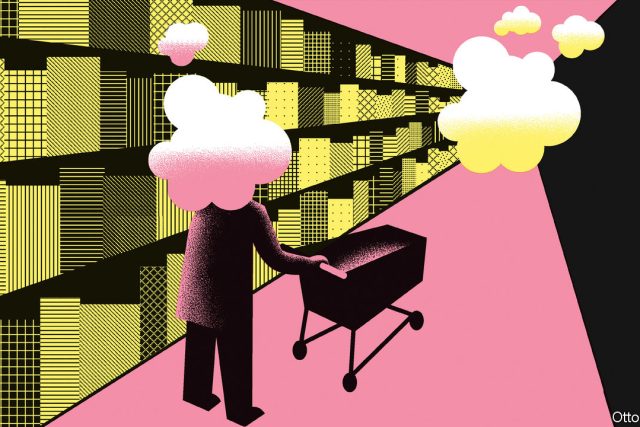It is an idea so seemingly obvious as to need little elaboration: people’s feelings influence their behaviour. In the economic realm this truism helps explain why surveys of consumer sentiment garner attention. They are seen as predictive of spending trends and, by extension, the state of the economy. But pause for a moment to examine how exactly sentiment affects the economy, and the causal chain starts to look sketchier. At the current juncture, when many think America is on the brink of recession, this oft-cited but fallible leading indicator merits closer inspection.
Understanding consumer spending is a holy grail for forecasters, since it accounts for about two-thirds of American gdp. Get it right, and the rest of the economy becomes much clearer. But the past couple of years have not been kind to those who focus on sentiment as a guide to future spending. The most closely watched index of consumer sentiment, published monthly by the University of Michigan, plunged to its lowest reading in more than four decades in 2022, and yet consumer spending remained resilient, even after accounting for inflation. This year, by contrast, the Michigan gauge has gained ground, and yet other indicators, including bond yields and lending flows, are flashing warning signs.
The main explanation for why sentiment has been more of a misleading than a leading economic indicator is that inflation has outweighed much else in consumers’ minds. To generate their measures, interviewers ask people questions such as whether they think the economy is heading in a good direction and whether they are planning to make big purchases. Consumers tend to be gloomy when prices soar, as happened last year. They give short shrift to slightly more complex factors, such as the big stash of savings many accumulated during the covid-19 pandemic.
But the gap between subjective pessimism and objective reasons for greater optimism highlights a quandary. The claim is that people’s feelings, whether justified or not, matter. When gloomy, they ought to spend less. If they contradict their own feelings and keep spending, then what exactly is the value of sentiment data?
It is a question that has bugged economists since consumer surveys got going after the second world war. In 1955 the Federal Reserve examined re-interviews of respondents, conducted a year after initial surveys, to see whether expectations predicted subsequent expenditures. Officials concluded that they did not. Rather than that being the final word, however, the sentiment industry only expanded over the years. In 1967 the Conference Board introduced its own consumer survey. In the 1980s abc, a television network, started sponsoring a weekly version, which was later taken over by Bloomberg, a data and media firm. Morning Consult, a pollster, launched a daily survey in 2018. Evidently, there is a big market appetite for sentiment indices, whatever their flaws.
To understand why, it is useful to consider a weaker case for such indices: not that they foretell the future but that they can reveal the present. An article in 1994 in the American Economic Review found that data on consumer confidence significantly improved forecasts of consumption growth when it was the sole explanatory factor. The problem is that when other variables such as incomes or employment were known, confidence data contributed little to the forecasts. On an intellectual level that is a damning assessment of the role of sentiment, showing that feelings by themselves have little bearing on the economy. But it indicates that surveys may have some use: sentiment reflects what people personally know about their incomes and their jobs, and it is these variables that ultimately influence their spending.
Sentiment gauges are especially prized given the time lag in economic data. The University of Michigan, for instance, published its preliminary consumer-sentiment index for April on the 14th. The Bureau of Economic Analysis will not publish data on personal incomes for April until May 26th. But even in such instances, their usefulness can easily be overstated. Monthly variations in sentiment surveys tend to be minor and volatile, much like the variations in spending patterns that they foreshadow.
A paper by the European Central Bank in 2011 found that sentiment indices were most useful in periods of upheaval. The bottom fell out of consumer surveys, for example, towards the start of the global financial crisis of 2007-09. Likewise, John Leer of Morning Consult notes that his company’s consumer index turned sharply negative in late February 2020, a month before the covid-induced downturn. Yet in truth, sentiment was far from the only sign that the economy was in trouble: a sharp sell-off in the stockmarket occurred at the same time, reflecting the barrage of bad news about the pandemic. Consumer surveys added to the picture of economic malaise. They hardly conjured it out of thin air.
Head in the clouds
Arguably the biggest virtue of sentiment surveys is simply that so many in the market monitor them. And it is not just investors. When the Fed raised interest rates by a whopping three-quarters of a percentage point last June—its first of four increases of that size—Jerome Powell, the central bank’s chairman, said that one factor was a jump in inflation expectations in the University of Michigan consumer survey. Duly informed, investors paid extra heed to the Michigan inflation reading for the next few months.
Could the downbeat sentiment indices of the past year eventually look prescient? There is, beyond consumer surveys, plenty of reason to think that an American recession may be in the offing at last: fallout from banking-sector turmoil and the ongoing debt-ceiling debacle come just as the labour market is starting to cool. But as Zachary Karabell wrote in a book about leading indicators in 2014, the conclusion is a more frustrating one: “Sentiment gauges are right just often enough to make them compelling and wrong far too frequently to make them reliable.” You do not want to look at them too closely, even if you cannot make yourself look away. ■
Read more from Free exchange, our column on economics:
Is China better at monetary policy than America? (Apr 20th)
How the state could take control of the banking system (Apr 12th)
Why economics does not understand business (Apr 4th)
Also: How the Free exchange column got its name




The Most Read
Сryptocurrencies
Bitcoin and Altcoins Trading Near Make-or-Break Levels
Financial crimes
Thieves targeted crypto execs and threatened their families in wide-ranging scheme
Financial crimes
Visa Warning: Hackers Ramp Up Card Stealing Attacks At Gas Stations
News
Capitalism is having an identity crisis – but it is still the best system
Uncategorized
The 73-year-old Vietnamese refugee is responsible for bringing Sriracha to American consumers
Uncategorized
Electric Truckmaker Rivian, Backed By Amazon, Ford, Raises Whopping $1.3 Billion